A Special Relationship? By Clive Mitchell, Wing Commander (Retd) RAF
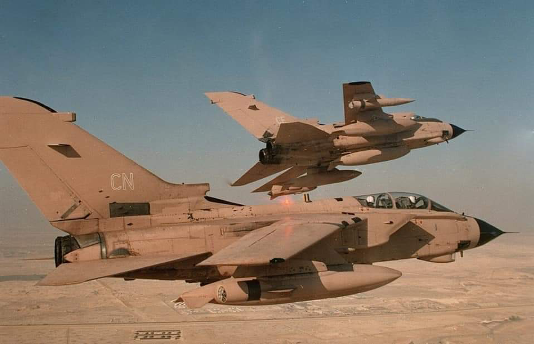
Flying CN during Desert Storm in 1991.
I recently retired from the Royal Air Force after a career spanning 37 years which included a lot of time spent alongside personnel from all of the US Services whilst working at the tactical, operational and strategic levels. My first experiences of US forces were operating the Tornado GR1 on US-led multi-national exercises, such as RED FLAG, in the late 1980s and early 1990s. Participation in such exercises proved very useful for the events of early 1991 when the Gulf War led to Combined Air Operations against Iraq. The previous experience of planning and flying together, providing an awareness of each other’s standard operating procedures, ensured that the transition to flying war fighting missions was relatively straightforward and likely saved lives and reduced aircraft losses. This was the prelude to 30 years of continuous operations alongside each other during which personnel at all levels have regularly met each other and developed close working and, often, personal relationships.
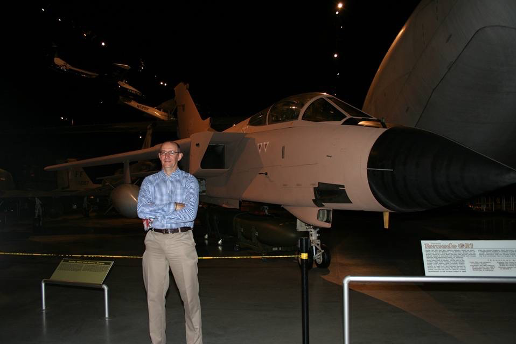
Reacquainted at the National Museum of the USAF in 2015.
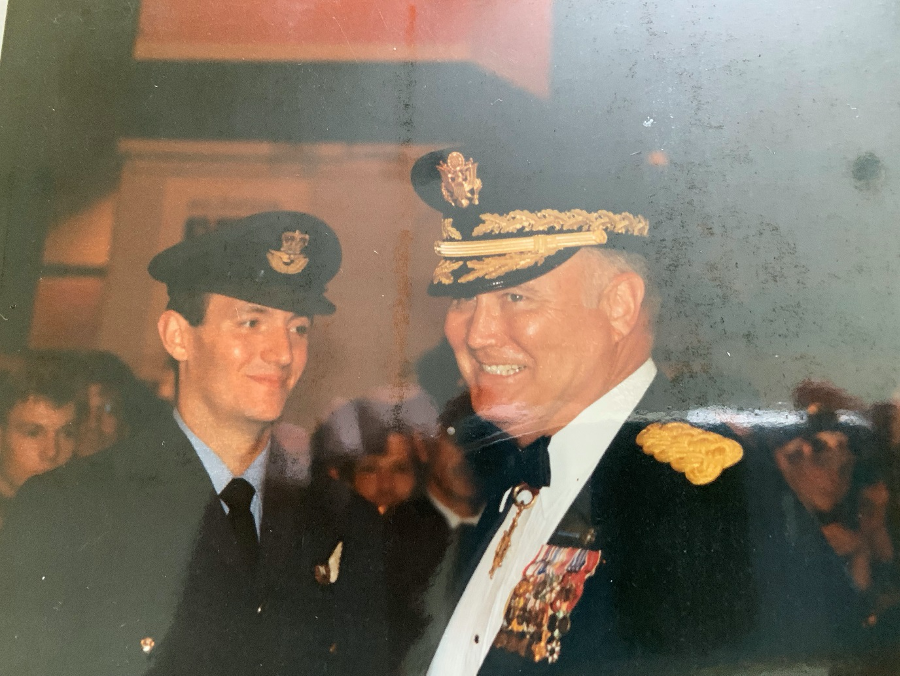
Meeting Gen Norman Schwarzkopf at the Royal Tournament, London, July 1991.
In 1993, I was assigned to a small unit then known as the Strike Attack Operational Evaluation Unit. As the name implies, the unit was involved in the evaluation of equipment and tactics prior to use on the front-line. Many of our tests and trials were conducted at US electronic warfare and weapons ranges at Nellis and Eglin AFBs. This provided an introduction to the US operational test and evaluation system and, more importantly, to the people who run it. Relationships built during this period remained extremely relevant in subsequent assignments. A decade on, I was assigned as the Commanding Officer of No.39 (1PRU) Squadron flying the Canberra PR9 in the strategic reconnaissance role. On arrival I found that I had a bunch of American, civilian, Field Service Representatives (FSRs) from Northrop Grumman, L3 and Raytheon working for me. Since 1997, when it received the Rapid Deployable Electro-Optical Systems upgrade, the PR9 had been fitted with the Senior Year Electro-Optical Reconnaissance System (SYERS) more commonly associated with the U2. This experience opened my eyes to the US Foreign Military Sales system and provided more useful contacts for later in my career. Despite the aircraft being more than 50 years old, the FSRs were key to ensuring that it remained operationally relevant until it was retired from Service in July 2006.
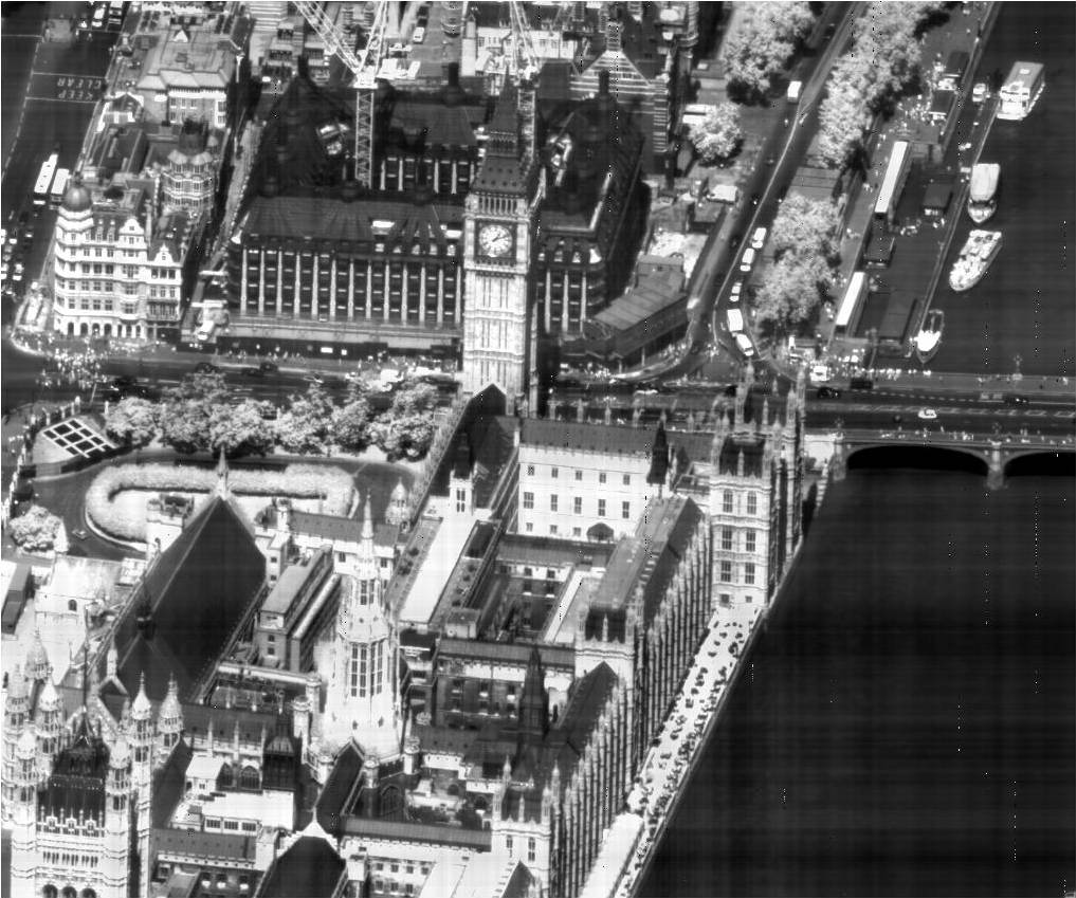
Image taken from the south coast of the UK using SYERS.
In 2009, I was given an 8-month assignment to US Central Command, led by Gen David Petraeus, as a liaison officer involved in strategic planning. This provided my first exposure to the US Army, gave me a good perspective on US joint operations and was the final block in preparing me for a 6-year stint on the British Defence Staff (United States) at the British Embassy in Washington DC.
From May 2013 to May 2019 I was assigned at the British Embassy with a broad portfolio which encompassed equipment procurement, administration of the Military Personnel Exchange Program (MPEP) and Defence Engagement. I had dealings with all US services and my previous experiences and relationships that I had built were key in delivering a successful outcome on many occasions. However, there are 2 areas that I feel particularly evoke the spirit of Billy Fiske. Firstly, in our shared history of the Second World War British Flying Training Schools. Well before the entry of the United States into the War in December 1941, Air Force officers in both countries had discussed the training of RAF pilots in the open and friendly skies of the US, in parallel with similar arrangements for the British Empire Air Training Scheme in Canada, Rhodesia and South Africa. Approval was finally given by President Roosevelt, under the Lend-Lease Act, in May 1941 and seven British Flying Training Schools were set up in short order as follows:
1 BFTS Terrell, Texas 9 June 1941
2 BFTS Lancaster, California 9 June 1941
3 BFTS Miami. Oklahoma 16 June 1941
4 BFTS Mesa, Arizona 16 June 1941
5 BFTS Clewiston, Florida 17 July 1941
6 BFTS Ponca City, Oklahoma 23 August 1941
7 BFTS Sweetwater, Texas May 1942 but closed August 1942
The first and largest of the schools was in Terrell, Texas. More than 2,200 Royal Air Force and United States Army Air Corps earned their wings over North Texas between 1941 and 1945. Terrell’s citizens welcomed the student pilots into their homes and their community, forging many life-long bonds which continue to this day. Former cadets started a museum in Terrell to remember their friendships and the twenty cadets who died there. The museum still retains a link to the British Embassy Air Staff and to Royal Air Force personnel who are assigned locally at Greenville. In 2017, we realised that a former cadet, Flight Sergeant John Tryon ‘Jack’ Bradshaw, who flew Spitfires in support of operations over Normandy in 1944, qualified for the French Legion of Honour but had never been awarded it. We liaised with the French authorities and they recognised his efforts. ‘Jack’ was made aware that he was to be awarded the medal but, regrettably, died just a few days before it could be presented. The medal was awarded to his son, John, at an emotional ceremony in Dallas in May 2017.
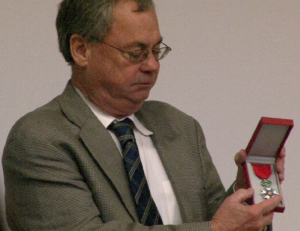
John Bradshaw with his dad’s Legion of Honour.
Secondly, the genesis of the current UK/US MPEP lies in Winston Churchill’s ‘Iron Curtain’ Speech, delivered at Westminster College in Fulton, Missouri, on March 5 1946. In his speech he clearly articulated the need for an exchange of personnel in order to glean mutual understanding and stated: ‘Now, while still pursing the method of realizing our over-all strategic concept, I come to the crux of what I have travelled here to say. Neither the sure prevention of war, nor the continuous rise of world organization will be gained without what I have called the fraternal association of the English-speaking peoples. This means a special relationship between the British Commonwealth and Empire and the United States of America. Ladies and gentlemen, this is no time for generality, and I will venture to the precise. Fraternal association requires not only the growing friendship and mutual understanding between our two vast but kindred systems of society, but the continuance of the intimate relations between our military advisers, leading to common study of potential dangers, the similarity of weapons and manuals of instructions, and to the interchange of officers and cadets’. Five years later, under the watchful eyes of General Hoyt Vandenberg and Marshal of the Royal Air Force Sir John Slessor, the USAF/RAF MPEP was created. One of the early exchange officers at the USAF Academy in Colorado Springs (April 1960 – June 1962) was Squadron Leader J A G Slessor, son of Sir John Slessor. In his end of tour report he concluded ‘I can only add that I hope that the frequent interchange of personnel between our two countries will be the means of our maintaining the friendship of so many officers, their families and civilians whom we have come to know so well. I share the conviction shared by my predecessor that the Exchange Scheme is an invaluable programme and it is clearly vital that the presence of exchange officers should be continued’. I was fortunate in being able to quickly develop a meaningful relationship with those in the Secretary of the Air Force International Affairs Department responsible for delivering the MPEP. We worked together for 5 years to ensure that more than 70 years on from Churchill’s speech, his vision of ‘intimate relations between our military advisers, leading to common study of potential dangers, the similarity of weapons and manuals of instructions, and to the interchange of officers and cadets’ remains valid and will do so for many years into the future.
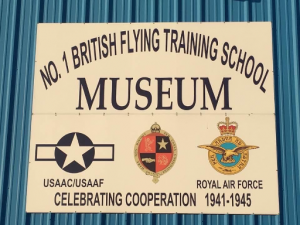
https://www.bftsmuseum.org/
I was first introduced to the amazing life story of Billy Fiske by the President of the Billy Fiske Foundation, Kevin Billings. I met Kevin early on during my time in the US and we immediately ‘hit it off’. Initial discussion focussed on our children; Kevin’s daughters both played soccer and, at that time, my son was at college in Wisconsin as an International Student on a soccer scholarship. We quickly discovered a mutual love of English rugby and English Premiership football (OK, soccer) and had many discussions over a pint or two of Guinness. Gradually, work also came into the equation and so it was that I was present at the inaugural Billy Fiske Dinner at the University Club on 17 August 2016. It was a small affair at which Kevin outlined his ideas for a statue of Billy in London which, I am delighted to see, are now coming to fruition.
Undoubtedly, the UK and the US have a unique relationship based on a shared history and experiences. Could that be termed a ‘Special Relationship’? Of course. However, what is more important, as hopefully my vignettes demonstrate, is the multitude of personal relationships, across all services and all ranks, which have been built up over many years of working together and which underpin the current relationship and the way that we interact. Without continued work and engagement across the services the relationship would whither. Currently, it is very healthy and I am confident that Billy Fiske would approve.
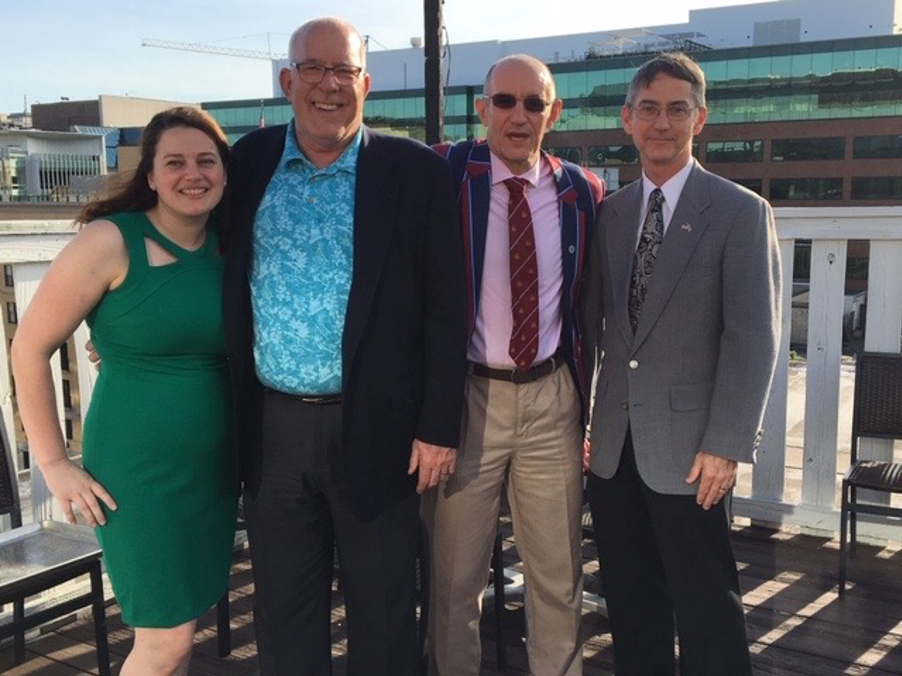
The ‘Dream Team’ – Members of Secretary of the Air Force International Affairs and British Defence Staff (United States) Air Staff reunited at my ‘leaving do’ in May 2019.
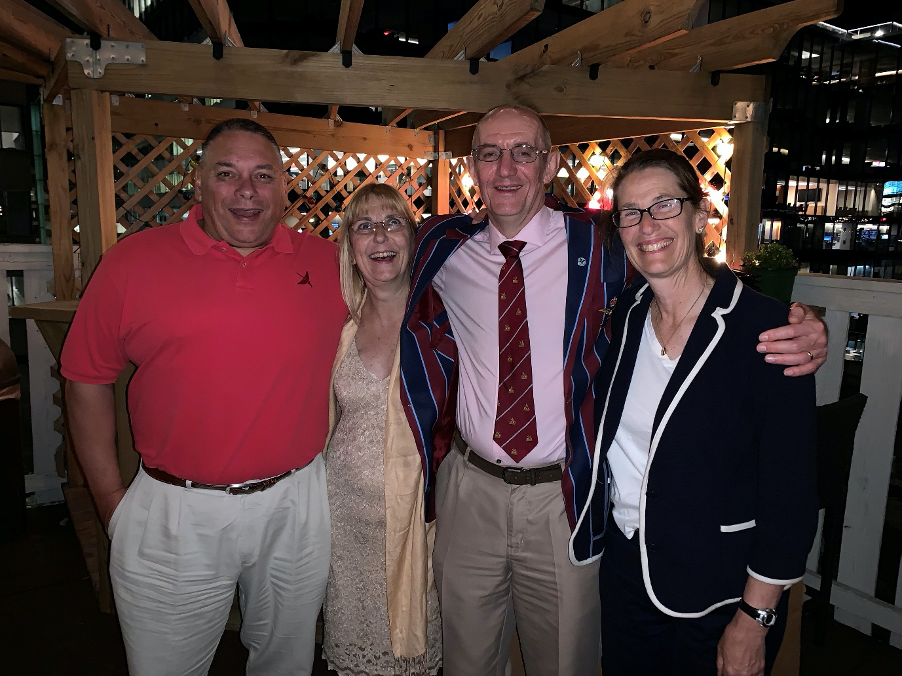
With the President of the Billy Fiske Foundation – May 2019.
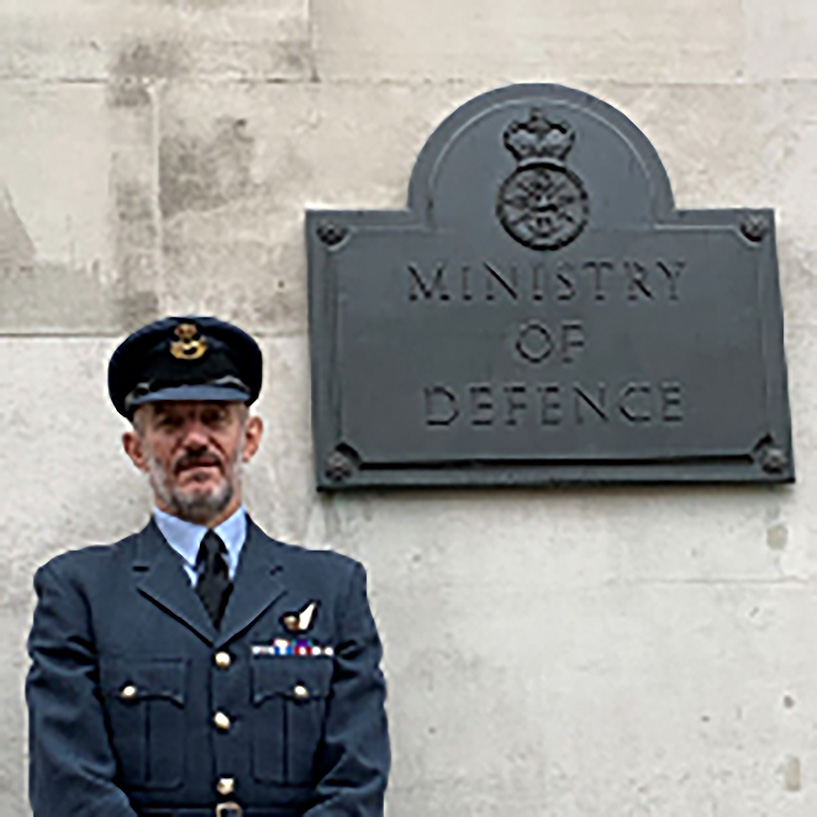
Clive Mitchell joined the Royal Air Force in 1982. On completion of both Initial Officer and Navigator Training he was assigned to a Canberra squadron operating in the Target Facilities role. In 1988 he re-roled to the Tornado GR1 ground attack aircraft and subsequently spent 3 ½ years at RAF Bruggen, in Germany, during which time he deployed to Dhahran, Saudi Arabia, for the duration of Operation GRANBY. Airborne on the first night of the campaign, he flew 18 missions delivering a variety of munitions against a varied target set. In 1993, Mitchell was posted to the Strike Attack Operational Evaluation Unit where he was involved in the development of operational tactics for the Tornado GR force and also trialed a variety of weapons, reconnaissance sensors and electronic warfare systems prior to their entry to Service.
Promoted to Squadron Leader in 1996, Mitchell endured a brief ground assignment at the Headquarters of Military Air Traffic Operations before returning to active flying duty with the Tornado GR1 fleet as the Executive Officer on 617 Squadron. During this tour he undertook numerous deployments to the Middle East in support of operations enforcing the UN No-Fly Zones over southern Iraq. Following this tour Mitchell conducted Advanced Command and Staff Training and, on completion, was assigned to the Staff.
In February 2004, Mitchell took Command of 39 Squadron, flying the Canberra PR9 in the strategic reconnaissance role. Over the next 2 ½ years much of his time was spent flying operations over Afghanistan. A posting to the Operations Directorate at the Ministry of Defence in London followed. As part of the Global Current Commitments Team, Mitchell was responsible for the provision of politically aware military advice to Ministers, other Government departments and Chiefs of Staff and for providing military strategic direction and planning guidance to the Permanent Joint Headquarters at Northwood.
In January 2009, Mitchell was deployed on an out-of-area operational tour to the Headquarters United States Central Command, Tampa Bay, Florida, where he dealt with military options for dealing with emergent world issues. From February 2010 to May 2013, Mitchell was the Deputy Defence Adviser at the British High Commission in Pretoria with the lead for air and naval issues. In May 2013, Mitchell joined the Air Staff at the British Defence Section United States in the British Embassy in Washington DC. His responsibilities included administration of the RAF personnel engaged in the Military Personnel Exchange Programme, support to equipment procurement initiatives and other Defence Engagement activity. Accordingly, he worked closely with USAF, USMC, USN and US Army personnel. Mitchell retired from the RAF on 31 October 2019 but immediately joined the RAF as a Full Time Reservist and currently works on a front-line RAF Station in support of Typhoon operations.
#billyfiskefoundation, #RAFbillyfiske




